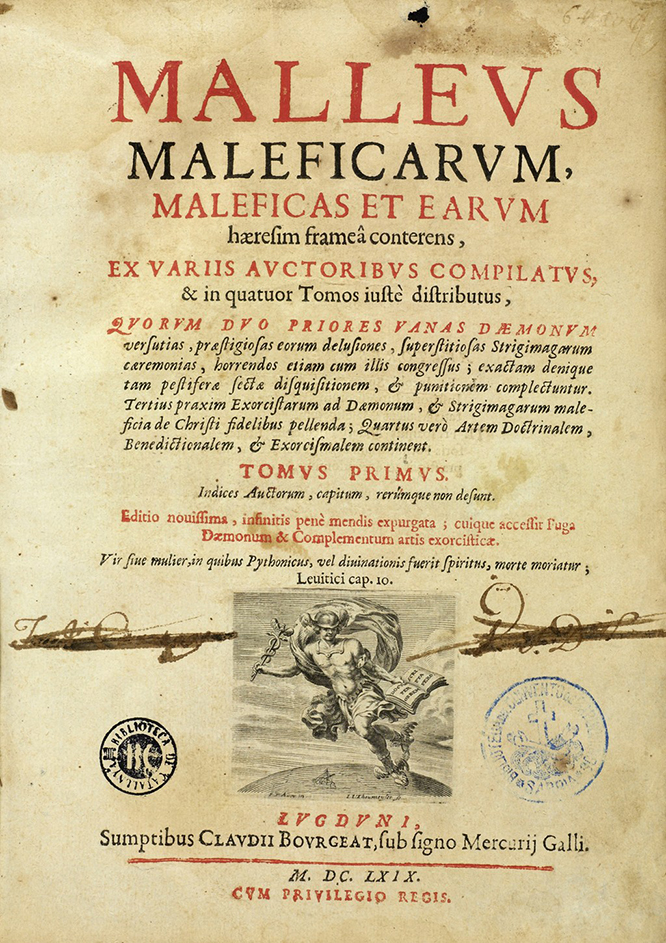Malleus Maleficarum
The Malleus Maleficarum, usually translated as the Hammer of Witches, is the best known treatise on witchcraft. It was written by the Catholic clergyman Heinrich Kramer (under his Latinized name Henricus Institor) and first published in the German city of Speyer in 1486. It has been described as the compendium of literature in demonology of the 15th century. The top theologians of the Inquisition at the Faculty of Cologne condemned the book as recommending unethical and illegal procedures, as well as being inconsistent with Catholic doctrines of demonology.
The Malleus elevates sorcery to the criminal status of heresy and recommends that secular courts prosecute it as such. The Malleus suggests torture to effectively obtain confessions and the death penalty as the only certain remedy against the evils of witchcraft. At the time of its publication, heretics were frequently punished to be burned alive at the stake and the Malleus encouraged the same treatment of witches. The book had a strong influence on culture for several centuries.
The book was later used by royal courts during the Renaissance, and contributed to the increasingly brutal witch-hunts during the 16th and 17th centuries.
Authorship
Jacob Sprenger's name was added as an author beginning in 1519, 33 years after the book's first publication and 24 years after Sprenger's death; but the veracity of this late addition has been questioned by many historians for various reasons.
Kramer wrote the Malleus following his expulsion from Innsbruck by the local bishop, due to charges of illegal behavior against Kramer himself, and because of Kramer's obsession with the sexual habits of one of the accused, Helena Scheuberin, which led the other tribunal members to suspend the trial.
Content
The Malleus Maleficarum asserts that three elements are necessary for witchcraft: the evil intentions of the witch, the help of the Devil, and the permission of God. The treatise is divided into three sections. The first section is aimed at clergy and tries to refute critics who deny the reality of witchcraft, thereby hindering its prosecution.
The second section describes the actual forms of witchcraft and its remedies. The third section is to assist judges confronting and combating witchcraft, and to aid the inquisitors by removing the burden from them. Each of the three sections has the prevailing themes of what is witchcraft and who is a witch.
Section I
Section I examines the concept of witchcraft theoretically, from the point of view of natural philosophy and theology. Specifically it addresses the question of whether witchcraft is a real phenomenon or imaginary, perhaps "deluding phantasms of the devil, or simply the fantasies of overwrought human minds." The conclusion drawn is that witchcraft must be real because the Devil is real. Witches entered into a pact with Satan to allow them the power to perform harmful magical acts, thus establishing an essential link between witches and the Devil.
Section II
Matters of practice and actual cases are discussed, and the powers of witches and their recruitment strategies. It states that it is mostly witches, as opposed to the Devil, who do the recruiting, by making something go wrong in the life of a respectable matron that makes her consult the knowledge of a witch, or by introducing young maidens to tempting young devils. It details how witches cast spells, and remedies that can be taken to prevent witchcraft, or help those who have been affected by it.
Section III
Section III is the legal part of the Malleus Maleficarum that describes how to prosecute a witch. The arguments are clearly laid for the lay magistrates prosecuting witches. The section offers a step-by-step guide to the conduct of a witch trial, from the method of initiating the process and assembling accusations, to the interrogation (including torture) of witnesses, and the formal charging of the accused. Women who did not cry during their trial were automatically believed to be witches.
